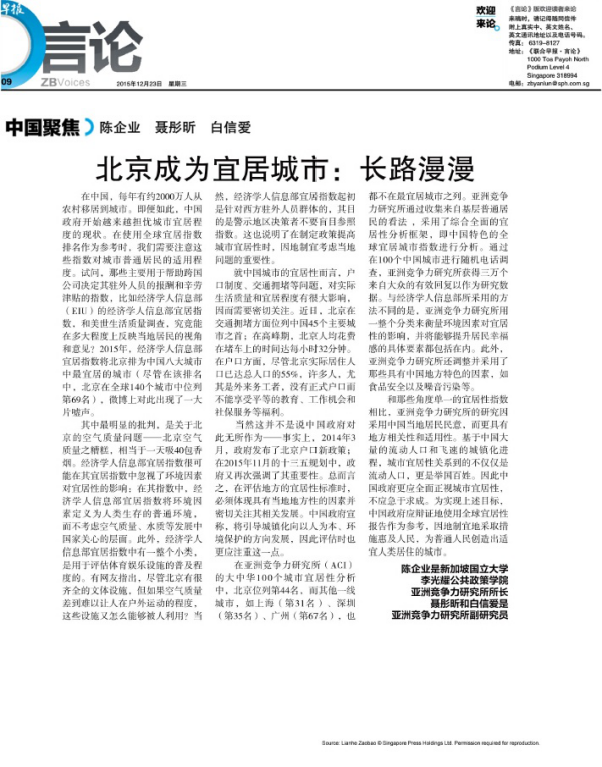

English Translation:
Beijing’s Long March to Liveability
A need for strategic assessment of liveability and the way forward for China
Tan Khee Giap, NieTongxin, ShinaeBaek
The Chinese government is sharpening its focus on the issue of liveability of its cities, even as 20 million people in China swap rural life for an urban one each year, and in 2014 it unveiled its urbanisation plan for the 2014-2020 period in an effort to steer the country’s urbanisation onto a human-centred and environmentally friendly path. The Chinese government, in its effort to benchmark best practice, may see global liveability rankings as reference or starting points for research for the purpose of enhancing liveability of its cities. Crucial to note in such an exercise is to critically assess the applicability of such indices to the ordinary residents of the cities.
Prominent indices such as the Economist Intelligence Unit (EIU)’s Liveability index and Mercer’s Quality of Living index were formulated for the purpose of aiding multinational firms determine their remuneration and hardship payments for the expatriate employees. How much do these factor in the sensitivity to context and perspective of local residents in their assessments? In 2015, Chinese online platform Weibo saw an outburst of criticisms among Chinese netizens in response to EIU’s ranking Beijing as the most liveable city among the eight Chinese cities it featured, albeit ranking only 69th out of the total of 140 global cities.
The biggest obvious criticism was that given Beijing’s exorbitant air pollution levels – seeing as breathing in Beijing’s air is as harmful as smoking 40 packs of cigarettes a day – EIU might have underestimated the impact of environmental factors on the liveability of a city. EIU, for its index, defined environment as the general climate, instead of the quality of the air or water, which is a formidable concern, especially in the developing world. In addition, the index has an entire environment dedicated to the availability and quality of sports infrastructure and leisure activities available. An astute question raised by a netizen was: “what is the good of Beijing having impressive football fields and public tracks, when the air quality is so poor such that it prohibits people from exercising outdoors?” Clearly, the intended audience for the EIU index was the Western expatriate community, serving as a warning signal to regional policy makers who blindly reference the index as a benchmarking tool. This underlines the importance of taking contextual concerns and issues into consideration when deriving policies to improve the liveability of cities.
Furthermore, with regards to liveability in China, issues such as traffic congestion and the household registration system, or the “hukou” system, need to be taken into consideration and monitored given their significant impact on the quality of living and practical liveability of Chinese citizens. Beijing recently topped the traffic congestion list of 45 major domestic cities within China, and it was found that commuters in Beijing spent on average 32 minutes per hour in traffic jams while travelling during rush hours.
Regarding the “hukou” system, although the number of people who actually live in cities is already near to 55% of the whole population, a significant number of them, mostly migrant workers, are denied official residence status and barred from equal education opportunities, employment rights, and social security services. In fact, it reiterated its commitment and announced plans for reform of the “hukou” system in the 13th Five-Year Plan in November 2015. In view of such potential constraints to liveability coming from local political or cultural considerations, it is therefore imperative that key issues in the local context be identified and pertinent developments addressed and closely monitored, in assessing and tackling the issue of the liveability of cities.
In the Asia Competitiveness Institute (ACI)’s research analysis of liveability of 100 Greater China cities, its 2015 Greater China Liveable Cities Index (GCLCI) ranked Beijing 44th out of 100 cities in Greater China (which includes Taiwan, Macau, and Hong Kong). In the index, all the first-tier cities failed to be identified as the most liveable cities in China, with Shanghai, Shenzhen, and Guangzhou ranking 31st, 35th, and 67th respectively. Beijing, in this case, fared worse than Shanghai and Shenzhen by a margin of more than 10 spots in the rankings.
The GCLCI is an adaptation of its comprehensive global liveability framework, namely the Global Liveable Cities Index (GLCI), adjusted to suit the context of China by incorporating grounds-up data from the vantage point of ordinary Chinese residents. ACI retrieved the data through random phone surveys conducted in 100 Chinese cities, which involved gathering 30,000 successful phone survey responses by ordinary residents in those 100 cities. Unlike the EIU’s approach, ACI has an entire environment dedicated to environmental factors with various components that cumulatively add up to the well-being of an ordinary resident. The creation of the index involved careful tweaking and adoption of new indicators that may be unique to but prevalent in China, but not necessarily applicable elsewhere, such as concerns on food safety, and noise levels in housing estates.
It is the focus on the sensibilities of the local Chinese citizen that makes ACI’s analysis applicable and relevant in the local context, compared to other indices that adopt a biased definition of liveability for a specific social group. Given the dramatic pace of internal migration and urbanisation in China, urban liveability is no longer a concern just for relocating expatriates. It concerns the majority of its domestic population. It is therefore paramount that the Chinese government treats liveability of its cities holistically, and not simply short circuit the process to achievequick wins.
To this end, the Chinese government should critically assess global comparative reports of liveability when using them as reference points, and focus on contextualising their approach to improving the liveability of China’s cities, catering to the needs of their citizens.
Dr Tan Khee Giap,
Co-Director of Asia Competitiveness Institute, LKYSPP, NUS
Mr NieTongxin and Ms ShinaeBaek
Research Associates at the ACI.
《城市建设理论研究(电子版)》 国际标准刊号:ISSN 2095-2104 国内统一刊号:CN 11-9313/TU







